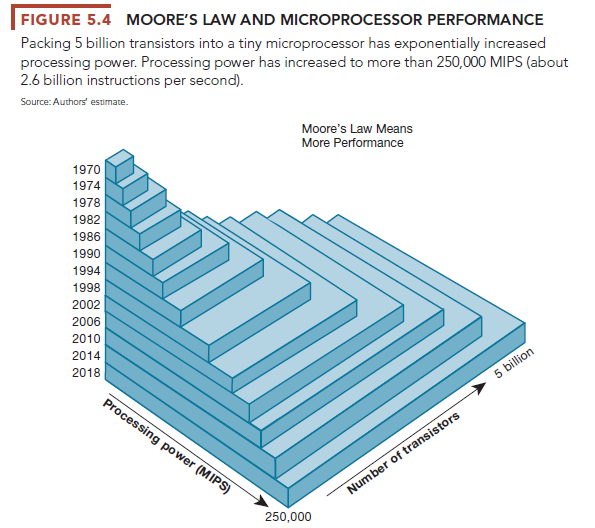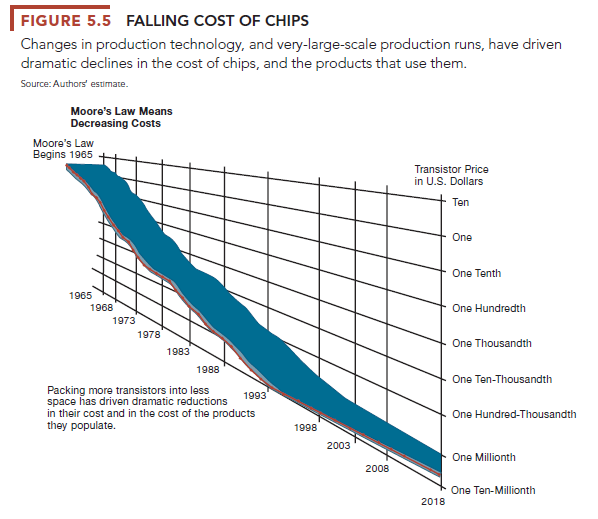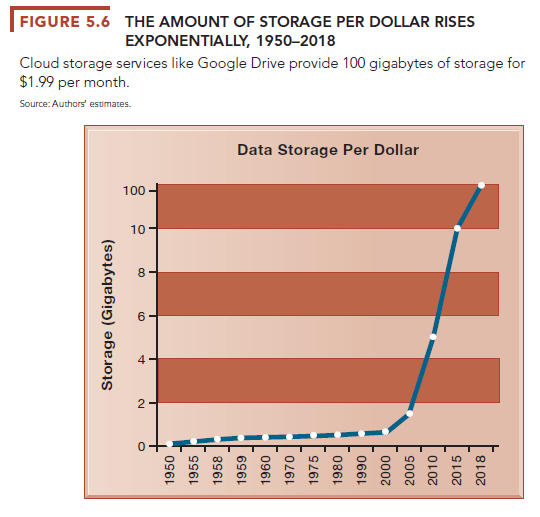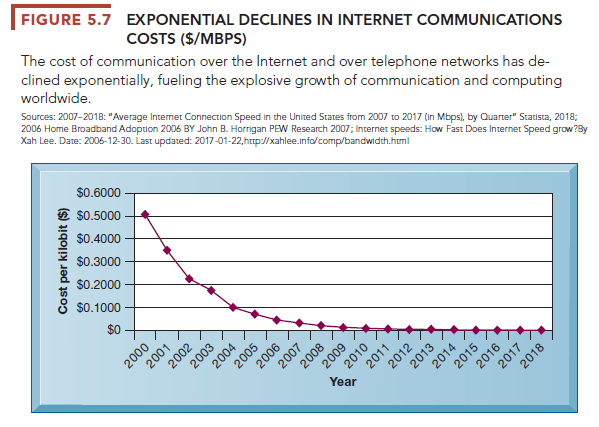The changes in IT infrastructure we have just described have resulted from developments in computer processing, memory chips, storage devices, networking hardware and software, and software design that have exponentially increased computing power while exponentially reducing costs. Let’s look at the most important developments.
1. Moore’s Law and Microprocessing Power
In 1965, Gordon Moore, the director of Fairchild Semiconductor’s Research and Development Laboratories, wrote in Electronics magazine that since the first microprocessor chip was introduced in 1959, the number of components on a chip with the smallest manufacturing costs per component (generally transistors) had doubled each year. This assertion became the foundation of Moore’s Law.
Moore later reduced the rate of growth to a doubling every two years.
There are at least three variations of Moore’s Law, none of which Moore ever stated: (1) the power of microprocessors doubles every 18 months, (2) computing power doubles every 18 months, and (3) the price of computing falls by half every 18 months.
Figure 5.4 illustrates the relationship between number of transistors on a microprocessor and millions of instructions per second (MIPS), a common measure of processor power. Figure 5.5 shows the exponential decline in the cost of transistors and rise in computing power. For instance, in 2018, you could buy an Intel i7 processor chip with 2.5 billion transistors for about one ten-millionth of a dollar per transistor.
Exponential growth in the number of transistors and the power of processors coupled with an exponential decline in computing costs may not be able to continue much longer. In the last five years, the cost improvement rate has fallen to single digits from 30 percent annual reductions. Chip manufacturers continue to miniaturize components. Today’s transistors are 14 nanometers in size, and should no longer be compared to the size of a human hair (80 thousand nanometers) but rather to the size of a virus (400 nanometers).
Within the next five years or so, chip makers may reach the physical limits of semiconductor size. At that point they may need to use alternatives to fashioning chips from silicon or find other ways to make computers more powerful.


Chip manufacturers can shrink the size of transistors down to the width of several atoms by using nanotechnology. Nanotechnology uses individual atoms and molecules to create computer chips and other devices that are thousands of times smaller than current technologies permit. Chip manufacturers are trying to develop a manufacturing process to produce nanotube processors economically. Stanford University scientists have built a nanotube computer.
2. The Law of Mass Digital Storage
A second technology driver of IT infrastructure change is the Law of Mass Digital Storage. The amount of digital information is roughly doubling every year (Lyman and Varian, 2003). Fortunately, the cost of storing digital information is falling at an exponential rate of 100 percent a year. Figure 5.6 shows that the number of megabytes that can be stored on magnetic media for $1 from 1950 to the present roughly doubled every 15 months. In 2018, a 1 terabyte hard disk drive sells at retail for about $50.
3. Metcalfe’s Law and Network Economics
Moore’s Law and the Law of Mass Digital Storage help us understand why computing resources are now so readily available. But why do people want more computing and storage power? The economics of networks and the growth of the Internet provide some answers.
Robert Metcalfe—inventor of Ethernet local area network technology- claimed in 1970 that the value or power of a network grows exponentially as a function of the number of network members. Metcalfe and others point to the increasing returns to scale that network members receive as more and more people join the network. As the number of members in a network grows linearly, the value of the entire system grows exponentially and continues to grow as members increase. Demand for information technology has been driven by the social and business value of digital networks, which rapidly multiply the number of actual and potential links among network members.

4. Declining Communications Costs and the Internet
A fourth technology driver transforming IT infrastructure is the rapid decline in the costs of communication and the exponential growth in the size of the Internet. Today there are 4.2 billion Internet users worldwide (Internetworldstats.com, 2018). Figure 5.7 illustrates the exponentially declining cost of communication both over the Internet and over telephone networks (which increasingly are based on the Internet). As communication costs fall toward a very small number and approach zero, utilization of communication and computing facilities explode. In 2018, one megabit of Internet access costs about $2.60. In 2000, the cost was over $300 if available. In this same time frame, average household Internet speeds have risen from .2 Mbps to 18 Mbps.
To take advantage of the business value associated with the Internet, firms must greatly expand their Internet connections, including wireless connectivity, and greatly expand the power of their client/server networks, desktop clients, and mobile computing devices. There is every reason to believe these trends will continue.
5. Standards and Network Effects
Today’s enterprise infrastructure and Internet computing would be impossible— both now and in the future—without agreements among manufacturers and widespread consumer acceptance of technology standards. Technology standards are specifications that establish the compatibility of products and the ability to communicate in a network.

Technology standards unleash powerful economies of scale and result in price declines as manufacturers focus on the products built to a single standard. Without these economies of scale, computing of any sort would be far more expensive than is currently the case. Table 5.1 describes important standards that have shaped IT infrastructure.
In the 1990s, corporations started moving toward standard computing and communications platforms. The Wintel PC with the Windows operating system and Microsoft Office desktop productivity applications became the standard desktop and mobile client computing platform. (It now shares the spotlight with other standards, such as Apple’s iOS and Macintosh operating systems and the Android operating system.) Widespread adoption of Unix-Linux as the enterprise server operating system of choice made possible the replacement of proprietary and expensive mainframe infrastructures. In networking, the Ethernet standard enabled PCs to connect together in small local area networks (LANs, and the TCP/IP standard enabled these LANs to be connected into firmwide networks, and ultimately, to the Internet.
Source: Laudon Kenneth C., Laudon Jane Price (2020), Management Information Systems: Managing the Digital Firm, Pearson; 16th edition.

this is a unique weblog
I truly appreciate this post. I have been looking all over for this! Thank goodness I found it on Bing. You’ve made my day! Thanks again!